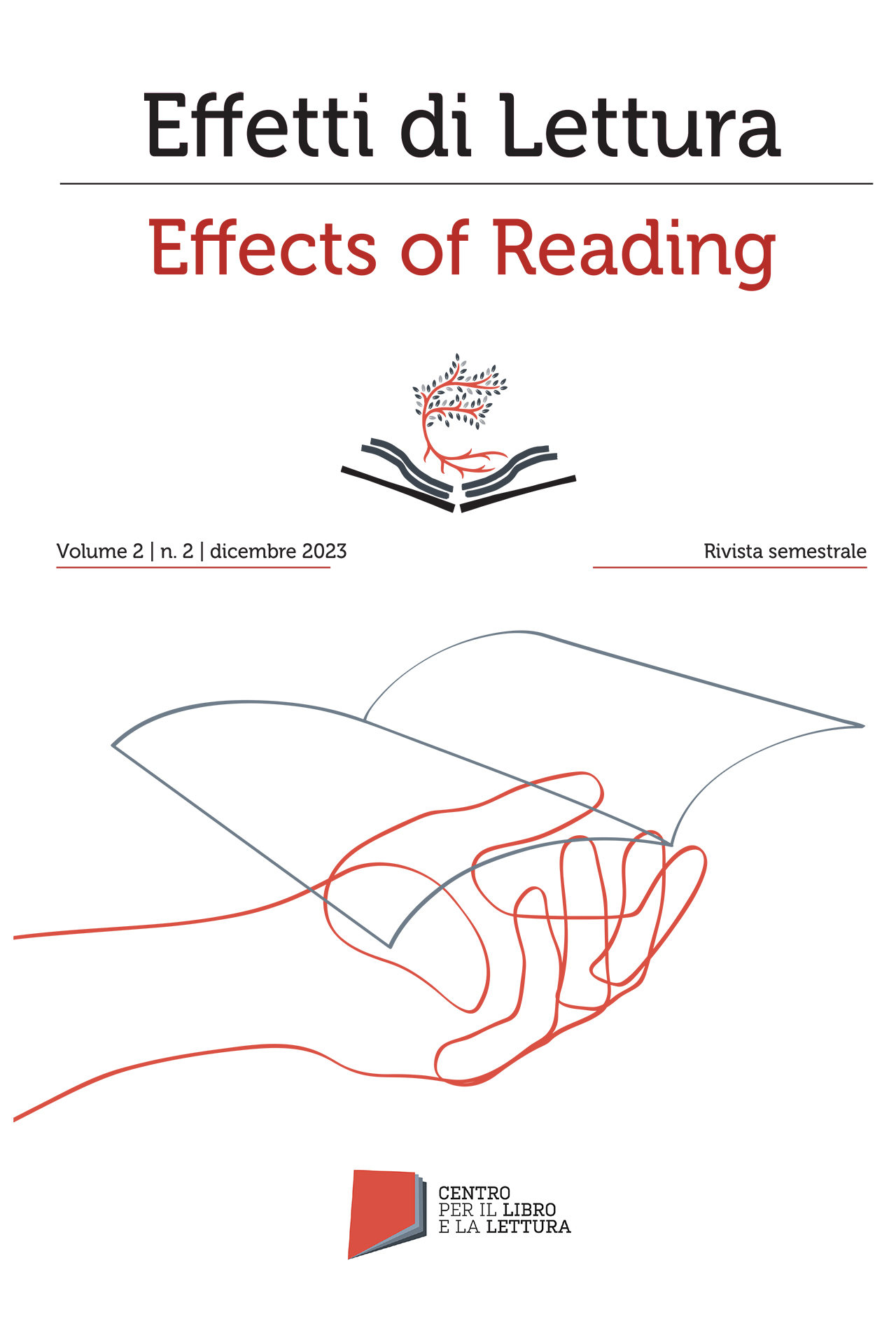The neurobiological, cognitive and cultural implications of the brain learning to read: an overview starting from the studies of Maryanne Wolf
DOI:
https://doi.org/10.7347/EdL-02-2023-04Keywords:
reading skills, emergent literacy, Maryanne Wolf, vocabulary enrichment, dyslexiaAbstract
The purpose of this contribution is to provide an overview of the brain processes that support reading skills, considering as well the difficulties that may impede a fully developed reading competence. We therefore address the biological and cultural origins of the neural circuits underlying the faculties of reading and writing from the perspective of neuroscience, and in particular Maryanne Wolf’s theories and findings, a world renowned cognitive neuro-scientist: starting from her essays Proust and the squid. The story and science of the reading brain (Wolf, 2009) and Reader, come home: the reading brain in a digital world (Wolf, 2018), we explore the vast implications that reading aloud produces on children in their first five years of life, referring specifically to early (or emergent) literacy development, as well as the impact that deep reading produces at multiple levels (cognitive, intellectual, emotional, affective and creative). Wolf introduces the concept of deep reading, referring to the ability of engaging with a text in a thoughtful, critical, and reflective way in order for the reader to make inferences from what they’ve read, but also to conceive new thoughts (Wolf, 2018, pp. 60–68): this capacity appears to be prerogative of the “expert reader”, and by exploring the stages that ideally lead to such profile, attention is paid to risk factors that may hinder reading progress, especially in situations of language deprivation and possible learning disabilities, such as dyslexia. Eventually, we consider the risks de-riving from excessive exposure to digital devices in the development of the executive functions, in-cluding attention, which is essential for analyzing and understanding complex texts.
Downloads
References
Ardissino, E. (2021). Poesie e storie per costruire un lessico scientifico a 3-6 anni. In E. Ardissino, F. Bosc (a cura di), Curiosare, sperimentare, dire. Lessico e conoscenze scientifiche nella scuola dell’infanzia (181–200). Franco Cesati Editore.
Ardissino, E. (2017). Lettura e letteratura. In E. Ardissino (a cura di), Insegnare a apprendere italiano nella scuola dell’infanzia e primaria (pp. 3–20). Mondadori Università.
Ardissino, E. (a cura di) (2010). Leggere poesia. 50 proposte didattiche per la scuola primaria. Erickson.
Batini, F. (2021). La lettura ad alta voce, per lo sviluppo del linguaggio, la comprensione di sé, degli altri, del mondo: la lettura ad alta voce come atto di cura. In V. Alastra, Cura di sé cura dell'altro e Humanities (pp.159–172). Pensa Multimedia.
Bortolotti, E., Zanon, F. (2006). Quando leggere diventa difficile. Il ruolo della didattica. Carocci editore.
Bosc, F. (2019). Poesia e lessico nella scuola primaria: primi risultati di un progetto. Italiano LinguaDue, 11(1), 443–452. https://doi.org/10.13130/2037-3597/11861
Coggi, C. (2015). Favorire il successo a scuola: il Programma Fenix dall’infanzia alla secondaria. Pensa Multimedia.
Commissione Europea, Agenzia esecutiva per l'istruzione, gli audiovisivi e la cultura (EACEA P9 Eurydice) (2011). Insegnare a leggere in Europa: contesti, politiche e pratiche. https://eurydice.indire.it/wp-content/uploads/2017/06/Teaching_reading_IT.pdf
Dallari, M. (2021). La zattera della bellezza. Per traghettare il principio di piacere nell’avventura educativa. Il Margine.
Dehaene, S. (2009). I neuroni della lettura. Raffaello Cortina Editore.
Decreto ministeriale n° 254 del 16 novembre 2012. Indicazioni nazionali per il curricolo della scuola dell'infanzia e del primo ciclo d'istruzione. Gazzetta Ufficiale n. 30 del 5 febbraio 2013. https://www.gazzettaufficiale.it/eli/id/2013/02/05/13G00034/sg
Fioroni, F. (2013). Neuroscienze e lettura. ENTHYMEMA, (8), 223–229. https://doi.org/10.13130/2037-2426/3039
Gilkerson, J., Richards, J. A., Warren, S. F., Montgomery, J. K., Greenwood, C. R., Oller, D., Hansen, J. H. L. and Paul, T. D. (2017). Mapping the Early Language Environment Using All-Day Recordings and Automated Analysis. American Journal of Speech-Language Pathology, 26(2), 248-265. https://doi.org/10.1044/2016_AJSLP-15-0169
Haverlock, E. A. (1976). Origins of Western Literacy. Four Lectures delivered at the Ontario Institute for Studies in Education, Toronto, March 25–28, 1974, Toronto: Ontario Institute for Studies in Education.
LEGGE n. 170, 8 ottobre 2010, Nuove norme in materia di disturbi specifici di apprendimento in ambito scolastico. Gazzetta Ufficiale N. 244 del 18 Ottobre 2010. https://www.istruzione.it/esame_di_stato/Primo_Ciclo/normativa/allegati/legge170_10.pdf
Negri, M. (2020). L’avventura del lettore: la letteratura come esperienza. In L. Cantatore, N. Galli Laforest, G. Grilli, M. Negri, G. Piccinini, I. Tondardini, E. Varrà, In cerca di guai. Studiare la letteratura per l’infanzia (205–251). Edizioni Junior.
Olson, D. (1977). From Utterance to Text: The Bias of Language in Speech and Writing. Harvard Educational Review 47 (3), (pp. 257–281), https://doi.org/10.17763/haer.47.3.8840364413869005
Pennac, D. (2008). Diario di scuola, Giangiacomo Feltrinelli Editore.
Pinto, G., Bigozzi, L. (a cura di) (2002). Laboratorio di lettura e scrittura. Percorsi precoci per la consapevolezza fonologica, testuale e pragmatica. Edizioni Erickson.
Platone, Bonazzi, M. (traduzione e cura di) (2011). Fedro. Einaudi Editore.
Pontecorvo, C. (1991). Dalla costruzione del sistema di scrittura all’attività dello scrivere. In Orsolini, M. e Pontecorvo, C. (a cura di), La costruzione del testo scritto nei bambini (pp. 29–53). La Nuova Italia.
Sala, A. (2023, settembre). Il ruolo della lettura ad alta voce nell’alfabetizzazione emergente. Implicazioni cognitive ed emotive delle storie nello sviluppo linguistico. Rivista Infanzia n. 3 (luglio/settembre), pp. 40–45. http://www.rivistainfanzia.it
Terrusi, M. (2011). Leggere il visibile: il mondo figurato delle pagine. Forma e poetica dei libri per la prima infanzia. In E. Beseghi, G. Grilli (a cura di), La letteratura invisibile. Infanzia e libri per bambini (143–164). Carocci editore.
Todorov, T. (2008). La letteratura in pericolo, Garzanti.
Wolf, M. (2009). Proust e il calamaro. Storia e scienza del cervello che legge. Vita e Pensiero.
Wolf, M. (2018). Lettore, vieni a casa. Il cervello che legge in un mondo digitale. Vita e pensiero.
Downloads
Published
How to Cite
Issue
Section
License
Copyright (c) 2024 Effetti di lettura / Effects of reading

This work is licensed under a Creative Commons Attribution-NonCommercial 4.0 International License.








